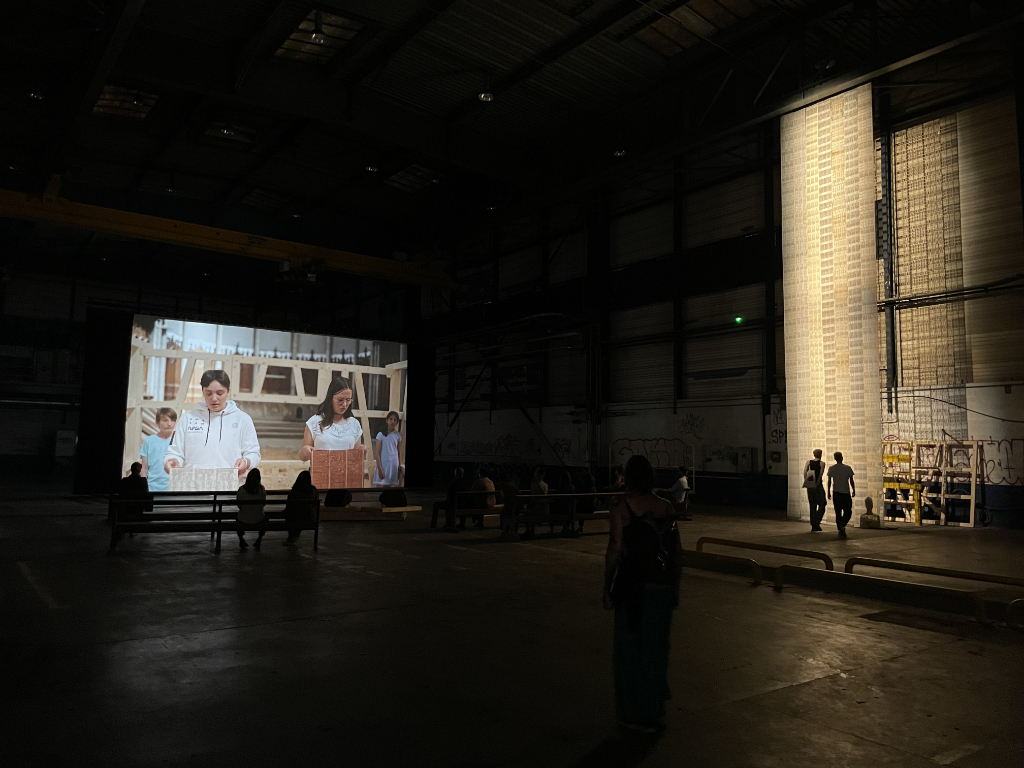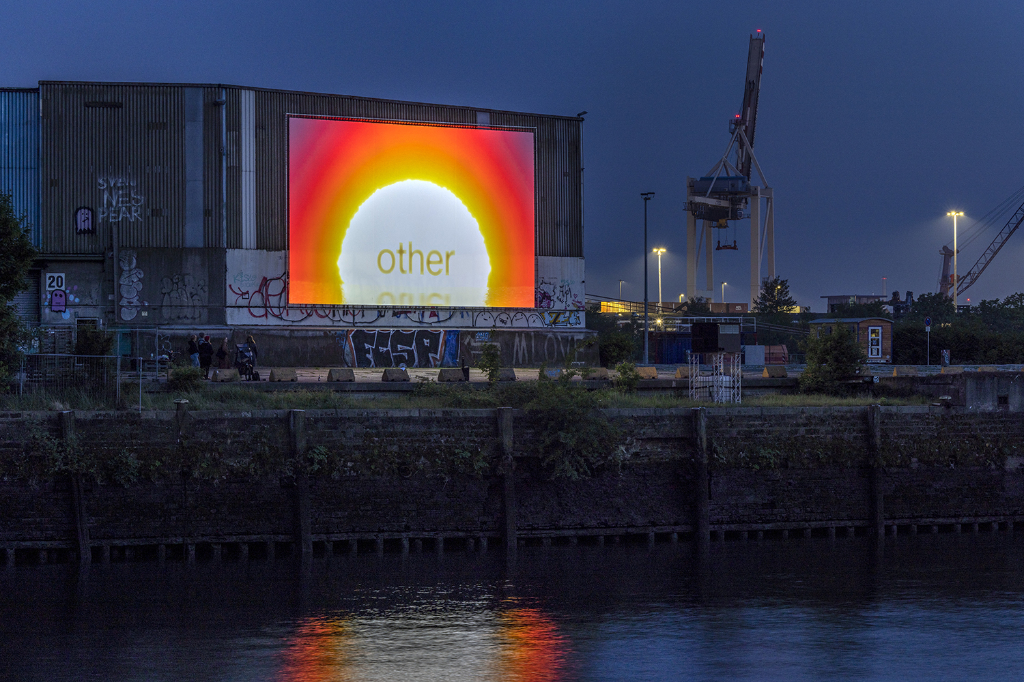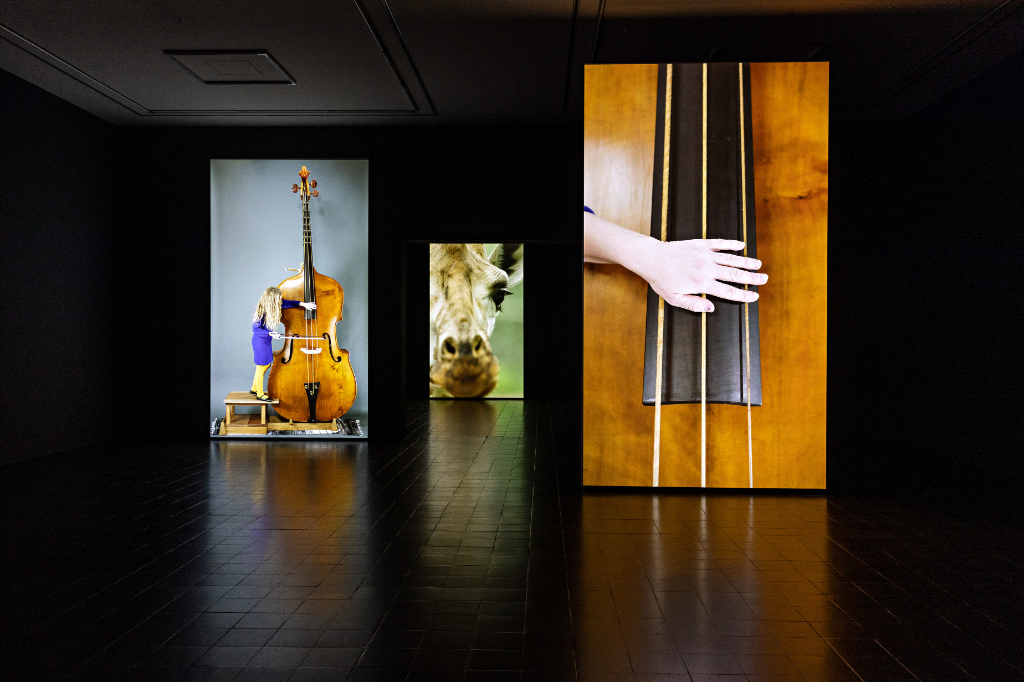Interview by Katažyna Jankovska

How the sound forms our imagination of processes and places? In her artistic practice, Annika Kahrs explores sound as a form of non-verbal communication, interpretation, and translation, addressing its cultural and social functions. She often works with sounds that are beyond our immediate perception, such as, for instance, sounds in the infrasonic range. Translating otherwise complex phenomena, Kahrs explores how music and sound can open up new realms of imagination and interpretation.
Annika’s works blend staged acts, documentary–like footage, and, most importantly, music. Music in Kahrs’ work plays an essential role, being presented in audio and visual forms. Often in Kahrs’ video–works, one can see orchestras, musical instruments, and performances unfolding in carefully selected places (e.g. how to live in the echo of other places audiovisual installation staged in the last unrenovated warehouse building in the former Free Port of Hamburg, Le Chant des Maisons filmed in the church of St. Bernard in Lyon, A Concert for the Birds – Kahrs’ first public artwork staged in one of Bristol’s oldest chapels).
Some of Annika’s work explores the use of sound as a means of communication. In her film Infra Voice (2018), Kahrs juxtaposes an animal and an octobass making contact through sound. Octobass plays the central role in the piece – the instrument’s lowest note is inaudible to human ears, as it is in the infrasound range, yet resembles the sound produced by giraffes. In another work, Playing to the Birds (2013), Annika presents a piano standing in a musical salon surrounded by birdhouses with various domesticated birds. The piano piece mimics the singing of birds. Kahrs’ video raises speculations about music becoming a universal language bridging realms of human and animal worlds.
In her latest work, Gravity’s Tune, Annika focuses on another phenomenon – gravitational waves. Focusing her attention on the extraterrestrial sounds, the new video work is an artistic-musical exploration of gravitational waves. First captured and made audible in 2015 by LIGO (Laser Interferometer Gravitational-Wave Observatory), gravitational waves are the circular ripples that form in the cosmos when, for example, two black holes in the universe orbit, collide, and merge.
Created in collaboration with the composer Louis d’Heudières, the work presents a live performance and a video. Translating the captured chirping sound into the twelve-piece musical composition, Gravity’s Tune suggests the power of music to translate sounds and form our imagination of processes that are hardly perceptible to us.



Your artistic practice can be described as one that opens up the world of inaudible sounds. Could you share your earliest interests and inspirations that led you to explore sounds beyond your immediate perception?
I am fascinated by inaudible sounds and how they are transformed and translated into our audible perception. The world of inaudible sounds is one interest in my work. But I would say that in my performances, film works, and sound installations, I am particularly interested in the importance of music and sound – acoustic information – in various social, scientific, cultural and political structures of coexistence. My earliest interest in sounds beyond human perception started with the phenomena of infrasound. Infrasound is a low-frequency sound wave below 20 Hz.
At that time, I was fascinated by the obscure instrument octobass. An octobass is an extremely rare string instrument built for the first time in 1850, measuring 3.85 meters and whose lowest note is in the infrasound range and, therefore, inaudible to the human ear. The sound and look of this instrument are incredible: Imagine an oversized double bass that can produce sounds reminiscent of a truck or the creaking of an old ship.
While researching that topic, I came across a new scientific discovery describing that giraffes can produce a deep, harmonic sound, a so-called “nocturnal humming”. Those sounds are not in the range of infrasound, but they have an astonishing similarity with the timbre of the octobass.
In 2018, I created the three-channel video and sound installation “Infra Voice”, which brings together two unique protagonists – the octobass and the giraffe – on an acoustic and visual level. To me, infrasound and the giraffe’s nocturnal humming indicate that many acoustic signals lie beyond human perception and just as many signals we can hear but have not yet been discovered or understood.
Despite our physical limitations, we try to bring the non-perceptible within our communicative range. And here, too, it’s a matter of constantly exploring and negotiating ingrained and new information and so of a certain understanding or misunderstanding of a worldview.
Most of your projects, including your latest one, Gravity’s Tune, combine live performance and video elements. Could you explain how you integrate the visual component into your work, mainly when your primary focus is on sound? How does the visual element enhance or interact with the auditory experience?
My projects are often based on topics that focus on sound or derive from social, political and scientific contexts where sound plays an important role. But, the visual component plays an equal role in the execution of the work. Especially in my video works, the sound always coincides with and juxtaposes the images. The two elements are equal components that react to each other. I would never use music as background, nor would I use an image just to highlight sound or music incidentally.
It happens often that the music only comes into being during the film process or during the performance itself. The performers create the sound or the music through their actions or knowledge. I often create a particular framework of activity in which the performers operate freely and can explore specific paths. I tend not to give precise directions because I am interested in generating a wide range of possibilities and allowing self-determined action within a predefined situation.
This also happens in my film “Gravity’s Tune”: you can see a music ensemble on stage who is working out the score of a gravitational wave throughout the film. In between, they are listening to a lecture by a scientist about the phenomena of the “sound” of gravitational waves. So, the film’s spectator can equally see and hear how the music piece is brought together.
Gravity’s Tune is a musical exploration of gravitational waves. Could you tell me more about the process behind the development of this work?
I would describe “Gravity’s Tune” as a video installation that entangles scientific and artistic thinking and addresses the interconnection of music and science. I wanted to tackle the astrophysical phenomena of gravitational waves poetically.
Gravitational waves are ripples in the space-time continuum that arise, for example, when two black holes merge. The energy released during those events is causing gravitational waves that compress and stretch space and time. They “travel” at the speed of light, spread out in space and eventually reach Earth, where they only have a tiny amplitude due to the usually (e.g. 1.8. billion years) long journey that lies behind them.
Detecting gravitational waves on Earth could be described as looking for a needle in a haystack. US-based LIGO (Laser Interferometer Gravitational-Wave Observatory) detected these waves in 2015 for the first time and translated these signals into a sound signal. When interpreted acoustically, gravitational waves can be represented as a concise “chirp sound”. The detection of gravitational waves is a significant scientific breakthrough by itself. Moreover, it is also the evidence for Einstein’s theory of relativity.
Usually, telescopes aiming at objects in space work with light and various types of photons. They are like your eyes. This telescope, LIGO, works more like your ears: What was once invisible to us is now something we can hear. The event of black holes colliding in complete darkness is now possible to detect – and can be translated into sound. We’ve effectively been given ears. I find this poetic and beautiful!
I have been in contact with a scientist from LIGO, Dr. Keith Thorne, for a couple of years. And our exchange inspired me to produce a work about gravitational waves and their musical potential. In one of our first exchanges, Keith described LIGO as the quietest concert hall on Earth. This thought was the starting point of my idea.
How does the film collide with both scientific and artistic thinking?
On the one hand, the film shows a concert hall with an ensemble on stage. They were given a score, basically a musical interpretation of a gravitational wave. The score is composed by Louis d’Heudières. He is a brilliant composer and a dear friend with whom I have been working for many years. Louis transformed the scientifically translated acoustic signal into a musical arrangement for these 12 musicians.
They did not rehearse the piece beforehand, so you can see and hear their lively and engaged discussions on how to play the score or find the right tune. On the other hand, you can see the control room from LIGO: A room with many screens and different charts, with scientists sitting concentrated and quiet at their desks and waiting for the subsequent detection of a Gravitational Wave.
Both places – the concert hall and the control room – are opposed and entangled. Dr. Keith Thorne appears as a mediator between these worlds. He shows up in both scenes: As a scientist and a conductor, even wearing a festive tuxedo in the concert scenes, he explains the astrophysical phenomenon of Gravitational Waves to the musicians and eventually to us, the spectators. The film ends with a concert where the musicians play three gravitational waves based on Louis’s score. It’s a very short concert, given that each composition is only a few seconds long.
For me, it was beautiful to see how the musical and scientific worlds are coming together and showing their connections. Both disciplines try to uncover the invisible and the hidden and thus make it visible and audible. Both try to understand complex systems, understandably present these, shift perspectives and build a relation to everyday life. They both know they are currently on the trail of something difficult to understand. But this something provides, at the same time, the imagination and the knowledge of the vastness of the universe.
What sparked your interest in using music to translate scientific processes, such as gravitational waves?
Music plays an essential role in my artistic work as a means of communication and as an element of translation. I would like to explain my interest in the mechanisms of translation and interpretation the following: If we picture the brain in a black box, so to speak, processing and interpreting all the signals it receives from outside – that is, absolutely everything we hear, see, feel, read and think, and making complex correlations between it all, to which it, in turn, reacts – then, interpretation and communication are fundamental.
It’s the starting point for everything else, all the ramifications and connections branching off everywhere. We are in a constant process of translating signals. But translation processes are, per se, relatively messy. Or, to put it more positively, Interpretation mechanisms leave a certain amount of latitude. And that is what interests me. There are many means of communication. Music, sound, and language are just two but two that I like to draw on in my work.
Were there any unexpected challenges or discoveries during the process?
On a practical level, there were quite some challenges. We postponed this project for a couple of years due to the pandemic. Keeping the excitement and focus over such a long time was difficult. My work is highly collaborative. Not being able to work in that way felt quite frustrating. But the extra time also allowed me to work more intensively on the project, develop further ideas and apply for additional funding.
The film shooting took place in Los Angeles, where the concert hall and the musicians are based and in Louisiana, where LIGO and Dr. Keith Thorne are. Keith also had to meet the musicians from Louisiana to Los Angeles. So logistically, we had a lot of things to organise and some problems to solve. But when everything finally came together and we shot the first scenes, we were thrilled even after such a long wait.
How do you usually select the place where the performance takes place? What role does the place play?
The place where my performances, film-shootings or installations take place is always chosen very carefully. The history or meaning of such a place plays an important role in the narrative of my work. In Le Chant des Maisons, which was created in 2022 for the 16th Biennale de Lyon, I filmed a performance that shows an acoustic and visual process of construction and deconstruction, conducted by various musicians and several carpenters in the deconsecrated church of St Bernard in Lyon.
During the filmed performance, the carpenters build a wooden structure resembling a simple house inside the church. Different scenes show the musicians reacting to the building process and the sounds produced by the carpenters. The latter, in turn, operate musically alongside the musicians. The church tells many stories of class struggle, resistance and independence, faith and institutional religion, social change processes and community significance.
Once home to many different religious communities, La Croix-Rousse – the district where the church is based – in Lyon was changed from a “hill that prays” into a base of industrial, highly capitalist silk production, a “hill that labours”. Many of the Canuts (silk weavers) lived there. St. Bernard was built after the rebellions by the Canuts at their request to provide the Canuts community with its own space in its home quarter.
The church’s history basically determined most elements of the performance: A youth choir uses both the organ- and silk-loom punch cards scattered around as scores for their vocal performance, or an organ builder tries to produce new sounds with broken organ pipes. Music pieces being played refer to protest songs of the Canuts. There are a lot of references and codes to discover. But you can also just enjoy the music and performances in the film: the visual and aural blend of intense and relaxed moments, choreographed and chance encounters, melodies, drone sounds, vocal hubbub, and the sound of hammers and drills that fills the majestic hall of the church.
What other invisible/inaudible phenomena fascinate you?
It’s not an invisible or inaudible phenomenon, but last week, I had the chance to visit an anechoic chamber. This is a particular room whose walls are designed in such a way that they reflect almost no sound. And no outside sounds can penetrate. The lack of noise was an extraordinary feeling – very physical and emotional. Even though I wasn’t alone in the room, I felt enormous loneliness. Something important was suddenly missing. This experience fascinated me a lot, and I keep thinking about it. This may be something I want to explore more.
What’s your chief enemy of creativity?
Bureaucracy and daily office hustle.
You couldn’t live without…
A heart.





